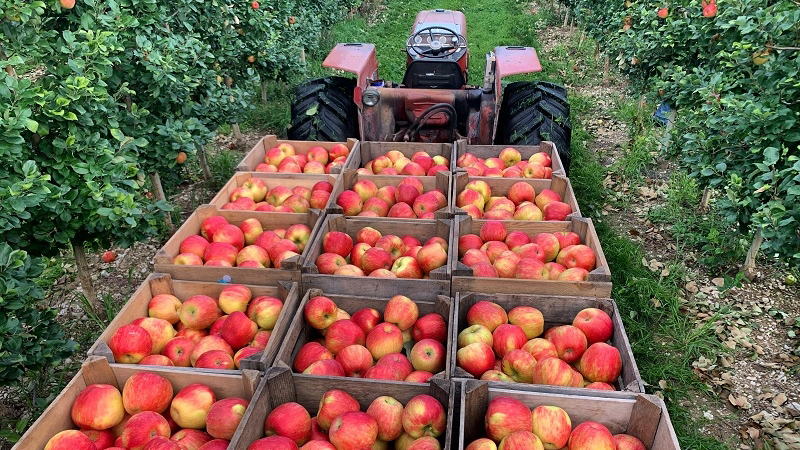Broad Mite Fight in Blackberries Rages On
Blackberry growers in the U.S. should concern themselves with broad mites and the threat they pose in fields and high tunnels, according to Dr. Donn T. Johnson, a retired Emeritus Professor of Entomology at the University of Arkansas.
“Each year I have had additional reports of broad mites causing significant damage to primocane-fruiting blackberries across the United States,” says Johnson, who addressed the topic in March at the annual meeting of the North American Blackberry and Raspberry Association.
Blackberry growers in Fayetteville, AR, first reported damaging broad mites in 2007, according to research performed by one of Johnson’s former master’s students, Jessica A. LeFors, who is now pursuing her doctorate at Texas A&M University-Texarkana. The first commercial damage to blackberries was reported in 2014, also in Arkansas.
Since then, the threat has spread from coast to coast. Nearly a dozen states in addition to Arkansas have detected broad mites on blackberries, including California, Illinois, Indiana, Maryland, New York, North Carolina, Oklahoma, Pennsylvania, South Carolina, Tennessee, and Virginia. Blackberries in China, South Africa, and Mexico have also been affected. And Florida has detected the pest in strawberries.
“The reason for the sudden prevalence of broad mites on blackberries is not known,” Johnson says, “but recent mild winters may be contributing factors.”
Studies out of Arkansas have shown that broad mites — the numbers of which typically drop to nearly zero through March and April — can nonetheless overwinter in leaf litter under blackberry canes.
“These mites may be overwintering in other states in a similar plant zone as Arkansas, with moderate winter temperatures,” Johnson says. “As minimum daily temperatures increase above 50°F through April, we start to see numbers of broad mites increase.”
By mid- to late-May, spotted eggs and the first adult males appear on expanding terminal leaves. Counts begin to exceed the damage threshold of five mites per leaflet. By mid-June, mites have dispersed from a few damaged plants — “hot spots,” Johnson says — to cause uniform counts above the damage threshold. Damage is evident throughout the planting.
“Future research is needed to determine how much of this dispersal is by mites walking to adjacent plants, wind and/or human activities, like tip pruning of primocanes, harvesting fruit from floricanes, or even air-blast spray applications,” Johnson says.
What to Look For
Broad mites feed on and inject saliva with toxin into expanding leaves and flower bud/fruit tissue on terminals and laterals of primocanes. This causes leaves to curl downward and/or upward. They shrivel and blister and become rigid, bronze, and less shiny than the typically light-green healthy leaves.
“In many cases, these leaves and flowers on terminals and laterals die, resulting in reduced and even no yield of primocanes in field and high tunnel plantings,” Johnson says.
Fighting Back
In May and June, growers should inspect primocane plantings weekly, looking for the first sign of broad mite damage of terminal leaves, Johnson says. If damage is seen, they should pick an expanding leaflet from the second leaf down from the terminal from each of 10 adjacent primocanes.
“Look for the presence of amber-colored adult broad mites on the underside of these leaflets, using a 30x to 60x jeweler’s LED hand lens or a stereomicroscope, which is usually available at your Extension office,” Johnson says. “We average the number of broad mites per leaflet from these 10-leaf counts. We have seen damage appear at about five broad mites per leaflet or when we see the first eggs and adult males on the leaflets. This is when we recommend applying a miticide.”
Treatment Efficacy
Various miticides have resulted in mite mortality rates of greater than 85%. If the temperature is above 90°F, Johnson touts two products:
• Agri-Mek SC (abamectin, Syngenta) with a non-ionic surfactant (NIS)
• Magister SC (fenazaquin, Gowan) (recently labeled against broad mites on caneberries in Arkansas, Florida, Georgia, Illinois, Maryland, North Carolina, Pennsylvania, South Carolina, and Virginia)
“The best summer treatment is Agri-Mek SC plus NIS,” he says.
If the temperature is less than 90°F, he cites four treatments:
• MPede (potassium salts of fatty acids, Gowan) 2%
• Microthiol (sulfur, UPL) 15 pounds per acre
• JMS Stylet Oil (paraffinic oil) 2%
• Trilogy (clarified hydrophobic extract of neem oil, Certis) 1%
These products “provided a two-week knockdown of broad mites,” Johnson says.
Researches are also seeing treatment success with predatory mites.
“To date, we had some suppression of broad mite numbers after releasing each of three predatory mites: Neoseiulus andersoni, Neoseiulus swirskii, and Neoseiulus californicus,” Johnson says. “However, more research is needed to identify the best species of predatory mites and numbers to release, timing of each release, and need to repeat releases in field or high tunnels to achieve biological control of broad mites in areas with varying climates where broad mites damage blackberries.”
Future Studies
On the topic of purchased blackberry plants, researchers have yet to conclude if they are free of broad mites, “so we recommend that growers look for broad mites on plants beginning to leaf out and, if present, to control them immediately,” Johnson says.
Research, he adds, is still needed to determine:
• if winter removal of understory leaf litter will greatly minimize broad mite numbers and delay spring and summer buildup of broad mites;
• what proportion of broad mites disperses across a blackberry planting by males walking to adjacent plants, wind, or human activity (tip pruning, fruit harvest, spraying, etc.);
• the best time to apply each effective miticide against broad mites and how to determine if it needs to be reapplied; and
• if there are effective strains of fungi, like Bacillus thuringiensis (Bt) that control broad mites.












